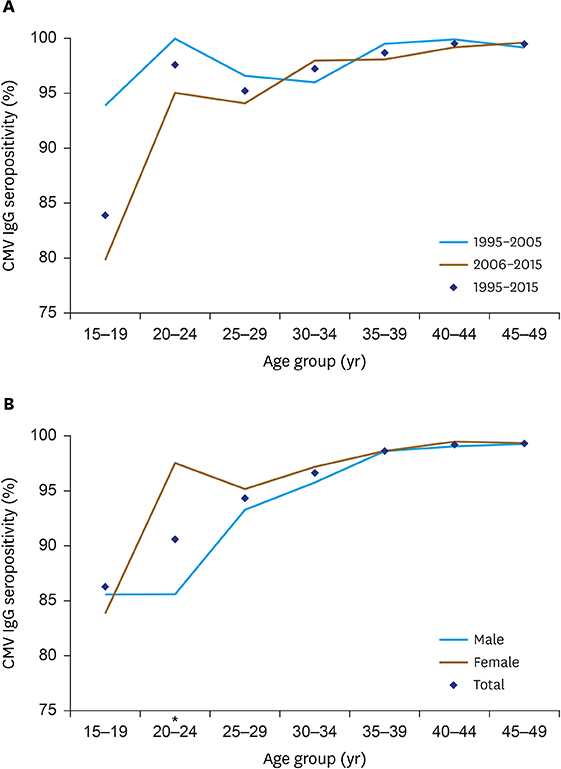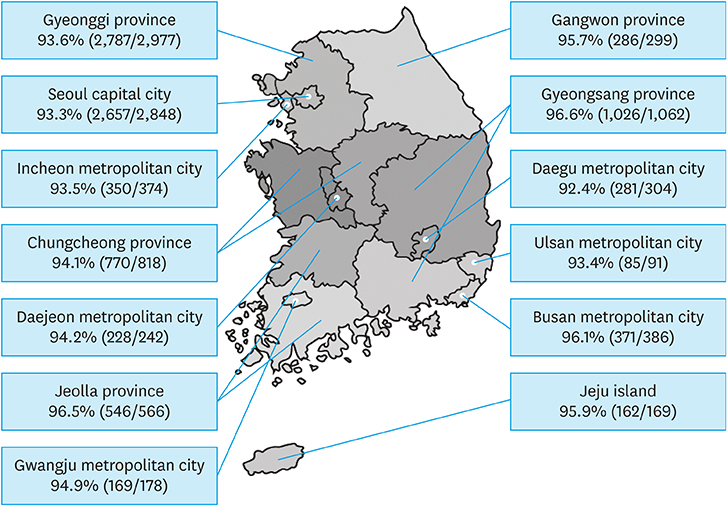Pediatr Infect Vaccine.
2018 Dec;25(3):123-131. 10.14776/piv.2018.25.e8.
Changes in Cytomegalovirus Seroprevalence in Korea for 21 Years: a Single Center Study
- Affiliations
-
- 1Department of Pediatrics, Samsung Medical Center, Sungkyunkwan University School of Medicine, Seoul, the Republic of Korea. yaejeankim@skku.edu
- 2Department of Pediatrics, National Cancer Center, Goyang, the Republic of Korea.
- 3Department of Pediatrics, Cheju Halla General Hospital, Jeju Special Self-Governing Province, the Republic of Korea.
- 4Department of Pediatrics, Myungji Hospital, Goyang, the Republic of Korea.
- 5Department of Gynecology and Obstetrics, Samsung Medical Center, Sungkyunkwan University School of Medicine, Seoul, the Republic of Korea.
- 6Department of Infectious Diseases, Samsung Medical Center, Sungkyunkwan University School of Medicine, Seoul, the Republic of Korea.
- 7Laboratory Medicine and Genetics, Samsung Medical Center, Sungkyunkwan University School of Medicine, Seoul, the Republic of Korea.
- KMID: 2428249
- DOI: http://doi.org/10.14776/piv.2018.25.e8
Abstract
- PURPOSE
Cytomegalovirus (CMV) infection is mostly asymptomatic but can be detrimental to certain hosts. We investigated changes of CMV seroprevalence in Koreans before and after the year 2000.
METHODS
We reviewed laboratory values of patients who were tested for CMV immunoglobulin G (IgG) at Samsung Medical Center, Seoul, Korea, from January 1995 to December 2015. Changes in seroprevalence were analyzed by gender, age, region, and tested year period (period 1, 1995-2005 vs. period 2, 2006-2015).
RESULTS
Overall CMV seropositivity was 94.1% (10,900/11,584). There was no significant difference for CMV seropositivity among the two periods (94.2% vs. 94.1%) (P=0.862). CMV seropositivity in the 11 to 20-year age group in period 2 (78.8%) was significantly lower than that of period 1 (89.9%) (P=0.001). The seropositivity of individuals aged 31-40 years (97.4%) was significantly higher than that of younger age groups (P < 0.001) and lower than that of older age groups (P < 0.001). Of 2,441 females of reproductive age (from 15 to 49), CMV seropositivity was 97% (2,467/2,441). The seropositivity in women aged 20-24-years was higher than that of men in the same age group (97.6% vs. 85.6%, P=0.003). No significant difference was observed among different regions.
CONCLUSIONS
Overall CMV seropositivity of Koreans was estimated to be 94% and the average seropositivity of reproductive women was 97%. Monitoring of the changes in seroprevalence including the reproductive age group is needed in the future.
Keyword
MeSH Terms
Figure
Cited by 2 articles
-
Conditioning with 10 Gy Total Body Irradiation, Cyclophosphamide, and Fludarabine without ATG Is Associated with Improved Outcome of Cord Blood Transplantation in Children with Acute Leukemia
Hee Won Cho, Hee Young Ju, Ju Kyung Hyun, Ji won Lee, Ki Woong Sung, Hong Hoe Koo, Do Hoon Lim, Keon Hee Yoo
J Korean Med Sci. 2021;36(19):e128. doi: 10.3346/jkms.2021.36.e128.Laboratory diagnostic testing for cytomegalovirus infection in solid organ transplant patients
Hyeyoung Lee, Eun-Jee Oh
Korean J Transplant. 2022;36(1):15-28. doi: 10.4285/kjt.22.0001.
Reference
-
1. Manicklal S, Emery VC, Lazzarotto T, Boppana SB, Gupta RK. The “silent” global burden of congenital cytomegalovirus. Clin Microbiol Rev. 2013; 26:86–102.
Article2. Lanzieri TM, Kruszon-Moran D, Amin MM, Bialek SR, Cannon MJ, Carroll MD, et al. Seroprevalence of cytomegalovirus among children 1 to 5 years of age in the United States from the National Health and Nutrition Examination Survey of 2011 to 2012. Clin Vaccine Immunol. 2015; 22:245–247.
Article3. Adler SP. Screening for cytomegalovirus during pregnancy. Infect Dis Obstet Gynecol. 2011; 2011:1–9.
Article4. Enders G, Daiminger A, Lindemann L, Knotek F, Bäder U, Exler S, et al. Cytomegalovirus (CMV) seroprevalence in pregnant women, bone marrow donors and adolescents in Germany, 1996–2010. Med Microbiol Immunol (Berl). 2012; 201:303–309.
Article5. Antona D, Lepoutre A, Fonteneau L, Baudon C, Halftermeyer-Zhou F, LE Strat Y, et al. Seroprevalence of cytomegalovirus infection in France in 2010. Epidemiol Infect. 2017; 145:1471–1478.
Article6. Stoykova ZD, Ivanova LI, Todorova TT. The role of cytomegalovirus in congenital and early postnatal infections in Northeastern Bulgaria. Folia Med (Plovdiv). 2017; 59:298–302.
Article7. Jin Q, Su J, Wu S. Cytomegalovirus infection among pregnant women in Beijing: seroepidemiological survey and intrauterine transmissions. J Microbiol Biotechnol. 2017; 27:1005–1009.
Article8. Pancharoen C, Bhattarrakosol P, Thisyakorn U. Seroprevalence of cytomegalovirus infection in children. Southeast Asian J Trop Med Public Health. 1998; 29:269–272.9. Wong A, Tan KH, Tee CS, Yeo GS. Seroprevalence of cytomegalovirus, toxoplasma and parvovirus in pregnancy. Singapore Med J. 2000; 41:151–155.10. Shigemi D, Yamaguchi S, Otsuka T, Kamoi S, Takeshita T. Seroprevalence of cytomegalovirus IgG antibodies among pregnant women in Japan from 2009–2014. Am J Infect Control. 2015; 43:1218–1221.
Article11. Chen MH, Chen PC, Jeng SF, Hsieh CJ, Su FC, Liao HF, et al. High perinatal seroprevalence of cytomegalovirus in northern Taiwan. J Paediatr Child Health. 2008; 44:166–169.
Article12. Oh YC, Choi BR, Kim CA, Cho MJ. A study for detection of IgG, IgM antibody to cytomegalovirus in blood donors. Korean J Hematol. 1989; 24:75–79.13. Park HK. Study of cytomegalovirus and herpes simplex virus antibodies in Korean pregnant women with complement fixation test. Ewha Med J. 1984; 7:191–197.
Article14. Seo SY, Park SJ, Hwang JY, Hahn SH, Kim SY, Kim HH, et al. The Alteration of the positive rate of cytomegalovirus IgG antibody among preschool period children. Korean J Pediatr. 2006; 49:51–55.
Article15. Lee KY. Seroepidemiology of cytomegalovirus in Taejon, Korea, in 1996. J Korean Pediatr Soc. 1998; 41:754–759.16. de Ory F, Ramírez R, García Comas L, León P, Sagües MJ, Sanz JC. Is there a change in cytomegalovirus seroepidemiology in Spain? Eur J Epidemiol. 2004; 19:85–89.
Article17. Takemoto K, Nishimura N, Kozawa K, Hibino H, Kawaguchi M, Takeuchi S, et al. Time-series analysis comparing the prevalence of antibodies against nine viral species found in umbilical cord blood in Japan. Jpn J Infect Dis. 2016; 69:314–318.
Article18. Korean Statistical Information Service (KOSIS). Population by census. Daejeon: Korean Statistical Information Service;2015.19. Puhakka L, Renko M, Helminen M, Peltola V, Heiskanen-Kosma T, Lappalainen M, et al. Primary versus non-primary maternal cytomegalovirus infection as a cause of symptomatic congenital infection - register-based study from Finland. Infect Dis (Lond). 2017; 49:445–453.
Article20. Kim CS. Congenital and perinatal cytomegalovirus infection. Korean J Pediatr. 2010; 53:14–20.
Article21. Voigt S, Schaffrath Rosario A, Mankertz A. Cytomegalovirus seroprevalence among children and adolescents in Germany: data from the German Health Interview and Examination Survey for Children and Adolescents (KiGGS), 2003–2006. Open Forum Infect Dis. 2015; 3:ofv193.
Article22. Taniguchi K, Watanabe N, Sato A, Jwa SC, Suzuki T, Yamanobe Y, et al. Changes in cytomegalovirus seroprevalence in pregnant Japanese women-a 10-year single center study. J Clin Virol. 2014; 59:192–194.
Article23. Shim YG. Complement-fixing antibodies against Cytomegalovirus among volunteer blood donors in Seoul area. Korean J Epidemiol. 1981; 3:99–104.24. Cho YK, Shim TS. Antibody positive rate in primary school children against cytomegalovirus as detected by ELISA method. Chung Ang J Med. 1982; 7:407–411.25. Kim CH, Shim TS. Antibody posses rate of schoolgirls against rubella and cytomegalovirus by ELISA method. Chung Ang J Med. 1982; 7:247–252.26. Baek SG, Shim TS. Antibody positive rate of cytomegalovirus by ELISA in preschool children. Off J Res Med Sci Korea. 1986; 18:46–50.27. Sohn YM, Park KI, Lee C, Han DG, Lee WY. Congenital cytomegalovirus infection in Korean population with very high prevalence of maternal immunity. J Korean Med Sci. 1992; 7:47–51.
Article28. Lee HJ, Jang SH. Prevalence of antibody to cytomegalovirus by anticomplement immunofluorescence test in Korean children. Korean J Infect Dis. 1993; 25:357–361.29. Kim YK, Kim DW. Seroepidemiology of human cytomegalovirus in healthy adults measured by means of the anticomplement immunofluorescence technique. Korean J Infect Dis. 1992; 24:87–92.30. Seo S, Cho Y, Park J. Serologic screening of pregnant Korean women for primary human cytomegalovirus infection using IgG avidity test. Korean J Lab Med. 2009; 29:557–562.
Article
- Full Text Links
- Actions
-
Cited
- CITED
-
- Close
- Share
- Similar articles
-
- Two cases of congenital cytomegalovirus infection
- A study of neonatal cholestasis and cytomegalovirus infection
- When is an Assay of Cytomegalovirus Antigenemia Useful in Detecting Cytomegalovirus Colitis?
- Cutaneous Cytomegalovirus Infection Presenting as Papules and Pustules in a Patient with Acquired Immunodeficiency Syndrome
- Shifting in Seroprevalence of HBsAg and Anti-HCV during Recent 10 Years in Adults Resident in Daegu and Gyeongbuk Province




